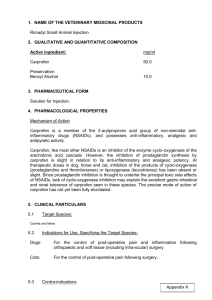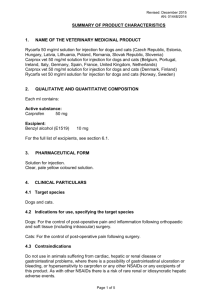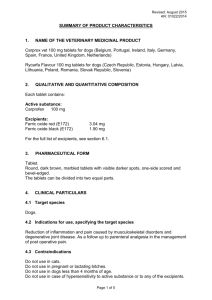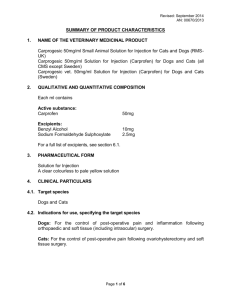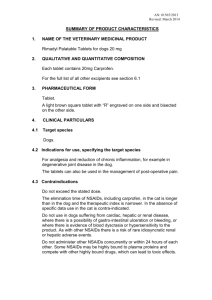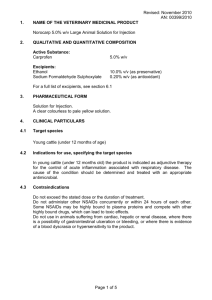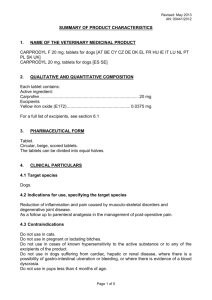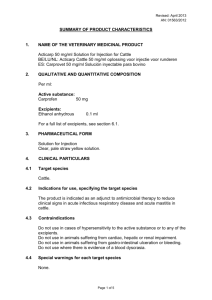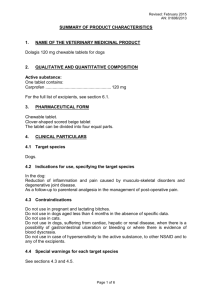Vm - Veterinary Medicines Directorate
advertisement
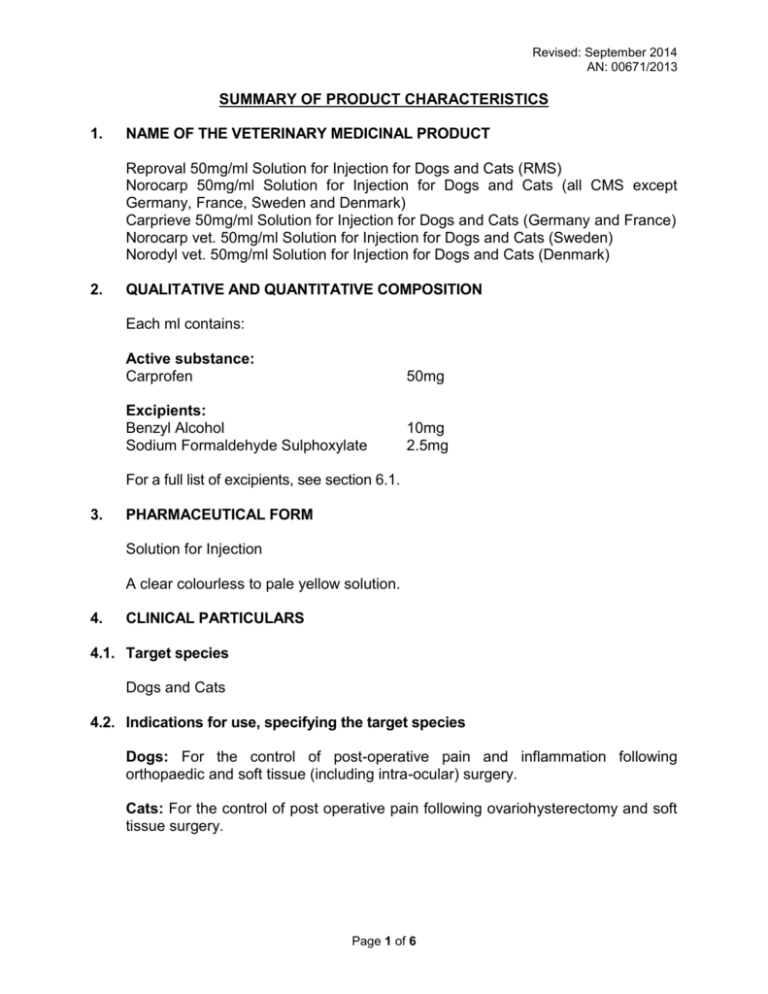
Revised: September 2014 AN: 00671/2013 SUMMARY OF PRODUCT CHARACTERISTICS 1. NAME OF THE VETERINARY MEDICINAL PRODUCT Reproval 50mg/ml Solution for Injection for Dogs and Cats (RMS) Norocarp 50mg/ml Solution for Injection for Dogs and Cats (all CMS except Germany, France, Sweden and Denmark) Carprieve 50mg/ml Solution for Injection for Dogs and Cats (Germany and France) Norocarp vet. 50mg/ml Solution for Injection for Dogs and Cats (Sweden) Norodyl vet. 50mg/ml Solution for Injection for Dogs and Cats (Denmark) 2. QUALITATIVE AND QUANTITATIVE COMPOSITION Each ml contains: Active substance: Carprofen 50mg Excipients: Benzyl Alcohol Sodium Formaldehyde Sulphoxylate 10mg 2.5mg For a full list of excipients, see section 6.1. 3. PHARMACEUTICAL FORM Solution for Injection A clear colourless to pale yellow solution. 4. CLINICAL PARTICULARS 4.1. Target species Dogs and Cats 4.2. Indications for use, specifying the target species Dogs: For the control of post-operative pain and inflammation following orthopaedic and soft tissue (including intra-ocular) surgery. Cats: For the control of post operative pain following ovariohysterectomy and soft tissue surgery. Page 1 of 6 Revised: September 2014 AN: 00671/2013 4.3. Contraindications Do not use in animals suffering from cardiac, hepatic or renal disease or gastrointestinal problems, where there is a possibility of gastrointestinal ulceration or bleeding, or hypersensitivity to carprofen or any other NSAIDs or any excipients of this product. As with other NSAIDs there is a risk of rare renal or idiosyncratic hepatic adverse events. Do not use after surgery which was associated with considerable blood loss. Do not use in cats on repeated occasions. Do not use in cats less than 5 months of age. Do not use in dogs less than 10 weeks of age. See also Section 4.7 and Section 4.8. 4.4. Special warnings for each target species In the cat, due to the longer half-life, and narrower therapeutic index, particular care should be taken not to exceed the recommended dose and the use of a graduated 1ml syringe is recommended to measure the dose accurately. 4.5. Special precautions for use i) Special precautions for use in animals Do not exceed the recommended dose or duration of treatment especially in the cat. Use in aged dogs and cats, may involve additional risk. If such use cannot be avoided, such animals may require a reduced dosage and careful clinical management. Avoid use in any dehydrated, hypovolaemic or hypotensive animal, as there is a potential risk of increased renal toxicity. NSAIDs can cause inhibition of phagocytosis and hence in the treatment of inflammatory conditions associated with bacterial infection, appropriate concurrent antimicrobial therapy should be instigated. ii) Special precautions to be taken by the person administering the veterinary medicinal product to animals Care should be taken when handling the product to avoid accidental self-injection and skin contact. If skin contact occurs wash any product from the skin immediately. Wash hands after use. Page 2 of 6 Revised: September 2014 AN: 00671/2013 4.6. Adverse reactions (frequency and seriousness) Typical undesirable effects associated with NSAIDs such as vomiting, soft faeces/diarrhea, faecal occult blood, loss of appetite and lethargy have been reported. These adverse reactions occur generally within the first treatment week and are in most cases transient and disappear following termination of the treatment but in very rare cases may be serious or fatal. If adverse reactions occur, use of the product should be stopped and the advice of a veterinarian should be sought. As with other NSAIDs there is a risk of rare renal or idiosyncratic hepatic adverse events. Occasionally reactions at the injection site may be observed following subcutaneous injection. 4.7. Use during pregnancy, lactation or lay Laboratory studies in laboratory animals (rat, rabbit) have shown evidence of foetotoxic effects of carprofen at doses close to the therapeutic dose. The safety of the veterinary medicinal product has not been established during pregnancy and lactation. Do not use in dogs or cats during pregnancy or lactation. 4.8. Interaction with other medicinal products and other forms of interaction Do not administer other NSAIDs and glucocorticoids concurrently or within 24 hours of the administration of the product. Carprofen is highly bound to plasma proteins and may compete with other highly bound drugs, which can lead to toxic effects. Concurrent administration of potential nephrotoxic drugs should be avoided. 4.9. Amounts to be administered and administration Dogs: In the dog, the recommended dosage is 4mg/kg (1ml/12.5kg) bodyweight, by intravenous or subcutaneous injection, best given pre-operatively, either at the time of premedication or induction of anaesthesia. Clinical trial evidence in dogs suggests that only a single dose of carprofen is required in the first 24 hours of the initial dose, however if further analgesia is required post surgery within this 24 hour period, a single half-dose (2mg/kg) of carprofen may be given to dogs as necessary. To extend analgesic and anti-inflammatory cover post-operatively, parenteral therapy may be followed with Carprofen Tablets at 4 mg/kg/day for up to 5 days. Page 3 of 6 Revised: September 2014 AN: 00671/2013 Cats: In the cat, the recommended dosage is 4mg/kg (0.24ml/3kg) bodyweight as a single dose by intravenous injection, best given pre-operatively at the time of anaesthesia. See also Section 4.4. For peri-operative use it is recommended to administer the product at least 30 minutes before anaesthesia. Precipitation may occur due to cold temperature. To re-dissolve warm and gently agitate the vial until precipitant is no longer evident. 4.10. Overdose (symptoms, emergency procedures, antidotes), if necessary There is no specific antidote for carprofen overdosage but general supportive therapy as applied to clinical overdosage with NSAIDs should be applied. 4.11. Withdrawal period Not applicable 5. PHARMACOLOGICAL PROPERTIES Pharmacotherapeutic group: Antiflammatory and antirheumatic products, non steroids ATCVet code: QM01 AE91 5.1. Pharmacodynamic properties Carprofen (CPF), ()-6-chloro--methylcarbazole-2-acetic acid, is a nonsteroidal anti-inflammatory drug (NSAID) with analgesic and anti-pyretic properties. It is a derivative of phenylpropionic acid and a member of the arylpropionic acid class of NSAIDs. As a representative of the 2-arylpropionic family, it contains a chiral center at C2 of the propionic moiety and therefore, exists in 2 sterioisomeric forms, the (+)-S and (-)-R enantiomers. The mechanism of action of carprofen is unclear, there are two principal theories. One proposes that carprofen is a selective inhibitor of the cyclo-oxygenase isoenzyme, COX-2. The second hypothesis that carprofen is a weak inhibitor of both cyclo-oxygenase isoforms, COX-1 and COX-2, and that it acts, at least partially, by some other unknown mechanism. However the S(+) enantiomer seems to be responsible for the selective COX2 inhibition of carprofen. The R(-) and S(+) enantiomers undergo glucuronidation and the S(+) enantiomer is subjected to enterohepatic recycling. Page 4 of 6 Revised: September 2014 AN: 00671/2013 5.2. Pharmacokinetic properties Following subcutaneous administration of 4mg carprofen/kg, peak plasma concentrations of 12.6 μg/ml were achieved in approximately 3 hours in dogs. Bioavailability following subcutaneous administration is in the range 90-100%. The volume of distribution is small with the highest drug concentrations occurring in plasma. Ratios of tissue to plasma concentration are less than one which is consistent with a high level of binding of carprofen to plasma proteins. Carprofen is primarily eliminated by biotransformation in the liver into glucuronide metabolites. 70 to 80% of metabolites are eliminated in faeces and 10-20% in urine. Following single subcutaneous administration of carprofen at a dose rate of 4 µg/kg bodyweight to dogs, the following parameters were observed for the individual enantiomers (R-) and (S+) and total carprofen: Cmax(R-) = 6.51 µg/ml, Tmax(R-) = 3.0 hours, AUC(R-) = 88.01 µg/ml.hours, t1/2(R-) = 9.098 hours; Cmax(S+) = 6.15 µg/ml, Tmax(S+) = 3.125 hours, AUC(S+) = 80.01 µg/ml.hours, t1/2(S+) = 8.139 hours; Cmax(total) = 12.6 µg/ml, Tmax(total) = 3.031 hours, AUC(total) = 168.31 µg/ml.hours, t1/2(total) = 9.0 hours. Following intravenous administration of carprofen to cats a half-life (t1/2) of 20.1±16.6 hours was observed. The elimination half-life of carprofen ranged from 9 to 49 hours. 6. PHARMACEUTICAL PARTICULARS 6.1. List of excipients Benzyl Alcohol Sodium Formaldehyde Sulphoxylate L-Arginine Poloxamer Type 188 (Lutrol F68) Water for Injections 6.2. Incompatibilities In the absence of compatibility studies this veterinary product cannot be mixed with other products. 6.3. Shelf-life Shelf-life of the veterinary medicinal product as packaged for sale: 2 years Shelf-life after first opening the immediate packaging: 28 days Page 5 of 6 Revised: September 2014 AN: 00671/2013 6.4. Special precautions for storage Do not store above 25°C. Do not refrigerate or freeze. Protect from light. 6.5. Nature and composition of immediate packaging 1 x 20ml, 5 x 20ml, 6 x 20ml, 10 x 20ml and 12 x 20ml multidose amber glass (Type 1) vials, sealed with 20mm bromobutyl bungs and 20mm aluminium seals. Not all pack sizes may be marketed. 6.6. Special precautions for the disposal of unused veterinary medicinal products or waste materials derived from the use of such products, if appropriate Any unused veterinary medicinal products or waste materials derived from such veterinary medicinal product should be disposed of in accordance with local requirements. 7. MARKETING AUTHORISATION HOLDER Norbrook Laboratories Limited Station Works Camlough Road Newry Co. Down BT35 6JP Northern Ireland 8. MARKETING AUTHORISATION NUMBER Vm 02000/4268 9. DATE OF FIRST AUTHORISATION Date: 02 August 2007 10. DATE OF REVISION OF THE TEXT Date: September 2014 Approved: 02 December 2014 Page 6 of 6
